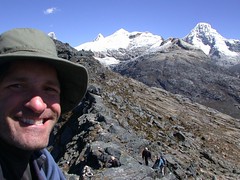Tuesday, July 15, 2003
A nitpick about Winged Migration
Anyone who knows me knows I have a deep fascination and respect for birds. And I was certainly excited when I learned of a movie called Winged Migration which came out recently. I saw it with Cindy some weeks ago, and was enchanted by the amazing cinematography. I had noted also a few odd aspects to the film while I watched it - things that seemed a little odd or out-of-place to me. But I let those things go at the time, and simply appreciated the remarkable viewpoints shared by the movie.
But as the weeks pass I think back more to the film, and now think that as great as the imagery was, as a whole it didn't really live up to its potential, or even form a truly coherent whole. I just came across a blog entry at Pedantic Nuthatch which describes the problems pretty well:
I had forgotten about that shot of the newly hatched cuckoo chick. I'll bet 90% of the people watching this movie had no idea about the context of that action (brood parasitism), that the cuckoo is in the nest of a different species of bird, placed there intentionally by the parent cuckoo. Of course, you can't blame the audience for not knowing these things, and I think the filmmakers should either have omitted that scene or explained what the heck it had to do with the rest of the story (as such). What did it have to do with migration?
The interposed human interaction with the birds was also incongruous. It almost seemed as if there was a point to be made, especially with the boy clipping the nettings away from the goose's leg. But it was generally so brief and had so little significance to the narrative that it certainly could have been left out without reducing the impact of the visuals. (This is especially true when you learn that some of the scenes were contrived by the director - not maliciously, but perhaps maladroitly).
Still, I do give a lot of credit to the editors for ensuring that the emotional manipulation was generally kept at a minimum. That is, shots of birds in difficult moments or facing certain death are restrained, and segue to different types of scenes almost immediately. And with over 400 hours of film from which to select just 90 minutes, we can only wonder what fascinating sequences may have ended up on the cutting room floor.
But as the weeks pass I think back more to the film, and now think that as great as the imagery was, as a whole it didn't really live up to its potential, or even form a truly coherent whole. I just came across a blog entry at Pedantic Nuthatch which describes the problems pretty well:
...I'm really concerned that non-naturalists will get a warped view of avian ecology. The only use of subtitling is to introduce species and give us an idea of the distances each migrates. The sparse voice-over narration is content-free, and leads us to believe that all species migrate to the Arctic. We see a cuckoo chick push a host egg out of the nest, with no explanation; we see various displays and outlandish vocalizations with no interpretation. The whole film degenerates into a series of music videos about "the whacky things those birds do."
The footage of birds in flight is dominated by Anseriformes (geese and their relatives), cranes, and other large birds—one surmises because birds of that order (1) fly during the day and (2) are most tolerant of the film-maker's equipment. Except for the bird parasitized by the cuckoo, there are no passerines (perching birds, of which the abundant songbirds make up the greatest number).
There's a lot of "Julia Child" natural history. A King Penguin is tending an egg, followed by a cut to a much larger chick attacked by skuas.
There's no question that there are some stunning images. The camera pans across an immense flock of Snow Geese in motion, until the frame is filled with white.
Just don't confuse this flick with a documentary.
I had forgotten about that shot of the newly hatched cuckoo chick. I'll bet 90% of the people watching this movie had no idea about the context of that action (brood parasitism), that the cuckoo is in the nest of a different species of bird, placed there intentionally by the parent cuckoo. Of course, you can't blame the audience for not knowing these things, and I think the filmmakers should either have omitted that scene or explained what the heck it had to do with the rest of the story (as such). What did it have to do with migration?
The interposed human interaction with the birds was also incongruous. It almost seemed as if there was a point to be made, especially with the boy clipping the nettings away from the goose's leg. But it was generally so brief and had so little significance to the narrative that it certainly could have been left out without reducing the impact of the visuals. (This is especially true when you learn that some of the scenes were contrived by the director - not maliciously, but perhaps maladroitly).
Still, I do give a lot of credit to the editors for ensuring that the emotional manipulation was generally kept at a minimum. That is, shots of birds in difficult moments or facing certain death are restrained, and segue to different types of scenes almost immediately. And with over 400 hours of film from which to select just 90 minutes, we can only wonder what fascinating sequences may have ended up on the cutting room floor.
Comments:
Post a Comment
